Abstract
The use of artificial oxygenation to counteract the effects of hypoxia and improve living standards in high-altitude, low-oxygen settings is widespread. A recognized consequence of this intervention is that it elevates the risk of fire occurrence. In this study, we simulated a real fire environment with low-pressure oxygen enrichment in a plateau area. A new multi-measuring apparatus was constructed by integrating an electronic control cone heater and a low-pressure oxygen enrichment combustion platform to enable the simultaneous measurement of multiple parameters. The combined effects of varying oxygen concentrations and thermal irradiance on the combustion behavior of wood plastic composites (WPCs) under specific low-pressure conditions were investigated, and alterations in crucial combustion parameters were examined and evaluated. Increasing the oxygen concentration and heat flux significantly reduced the ignition and combustion times. For instance, at 50 kW/m2, the ignition time decreased from 75 s to 16 s as the oxygen concentration increased from 21% to 35%. This effect was suppressed by higher heat fluxes. Compared with low oxygen concentrations and low thermal radiation environments, the ignition time of the material under high oxygen concentrations and high thermal radiation conditions was shortened by more than 78%, indicating that its flammability is enhanced under extreme conditions. Higher oxygen concentrations enhanced the heat feedback to the fuel surface, which accelerated pyrolysis and yielded a more compact flame with reduced dimensions and a color transition from blue-yellow to bright yellow. This intensified combustion was further manifested by an increased mass loss rate (MLR), elevated flame temperature, and a decline in residual mass percentage. The combustion of WPCs displayed distinct stage characteristics, exhibiting “double peak” features in both the MLR and flame temperature, which were attributed to the staged pyrolysis of its wood fiber and plastic components.
1. Introduction
China’s high plateau areas account for approximately 26% of the total land area. By 2023, there were 493 plateau towns with an altitude of more than 2500 m and a permanent population of approximately 60–80 million. Research indicates that among the inhabitants of the Plateau, the incidence rates of acute mountain sickness (AMS) and chronic mountain sickness (CMS) are as high as 50% and 20%, respectively, underscoring the significant challenges posed by hypoxic (low oxygen partial pressure), low-pressure conditions for urban development on the plateau [,,]. Artificial oxygenation technology improves the efficiency of human oxygen metabolism by increasing the concentration of ambient oxygen [,] and has been popularized in key places such as plateau medical institutions and transportation hubs. Compulsory oxygen supply standards have been implemented in some regions [,]. However, the low-pressure environment with artificially elevated oxygen concentration formed by this technology may change the combustion characteristics of combustibles and lead to new fire risks.
Wood plastic composites (WPCs) are an innovative class of eco-friendly construction materials formulated from recycled polyethylene, polypropylene, and other thermoplastic polymers, in combination with waste materials derived from agricultural and forestry sources [,]. This material combines the processability of wood with the weather resistance of polymers; therefore, it is widely used in the fields of construction, home furnishing, logistics, and industry, and has been widely used in hotels, hospitals, and other public places in high plateau areas. However, because the wood fibers and thermoplastic polymers constituting WPCs are flammable substances, the indoor fire risk may be further increased in low-pressure oxygen-enriched environments.
Although research on the behavior of low-pressure oxygen-enriched fires at home and abroad started late, its importance should not be underestimated. Experiments have shown that the combustion rate of materials in air increases exponentially with increasing oxygen concentration, particularly when the oxygen concentration exceeds 25% []. Simons [] studied the combustion rate of filter paper and cotton strips under varying atmospheric pressures while maintaining a constant oxygen partial pressure, and Dorr [] analyzed the influence of different air pressures and oxygen volume fractions on the combustion speed of filter paper. These studies consistently found that when the oxygen partial pressure was constant, the combustion rate of the material increased with decreasing pressure. Sara McAllister [] investigated how varying pressures and oxygen concentrations impact the ignition mechanism of PMMA, but did not fully consider the influence of the coupling effect of these two factors on the ignition characteristics. Nakamura [] conducted combustion experiments on solid cellulose paper by varying the pressure and oxygen concentration. In the pressure range of 40–101 kPa., the combustion rate was linearly and positively correlated with the oxygen partial pressure, whereas the relationship with the total ambient pressure was the opposite. Hirsch [,] evaluated the flammability risk of various materials by examining their flammability characteristics under varying oxygen concentrations and ambient pressures, and discovered that the limiting oxygen concentration (LOC) of the materials decreased as the total pressure increased and exhibited a linear and negative correlation with the oxygen partial pressure. Osorio et al. [] conducted combustion experiments on flame-retardant fabrics under pressures of 13–100 kPa and oxygen concentrations of 21–75%. The findings indicated that the oxygen concentration necessary to sustain flame combustion increased markedly as the pressure decreased. Xu H [] investigated the combustion characteristics of low-density polyethylene (LDPE) incorporating varying amounts of intumescent flame retardant (FR) under low-pressure conditions (55–101 kPa). The findings revealed that decreasing the pressure significantly elevated the heat release rate (HRR) while simultaneously reducing carbon monoxide (CO) emissions. Zhang J [] investigated the combustion behavior of polypropylene under diverse combinations of external thermal radiation and environmental pressure. Leveraging HRR data obtained under various pressure conditions, a novel low-pressure HRR prediction method was developed. However, the influence of oxygen concentration on fire characteristics under low-pressure conditions was not fully accounted for in this study.
In summary, most existing studies on the behavior of low-pressure oxygen-enriched fires focus on the self-sustaining combustion process without external radiant heat flow, while there is still a lack of systematic research on the dynamic coupling mechanism between heat flow intensity and oxygen transport in real fire scenarios. In addition, no studies have been reported on the combustion characteristics of wood plastic composites (WPCs) in low-pressure oxygen-enriched environments. In this study, a novel multiparameter system was developed by integrating an electronically controlled cone heater with a low-pressure oxygen-enriched combustion platform. By accurately controlling the external irradiance and oxygen concentration, the indoor environment of artificial aeration in a plateau area was simulated. The effects of different oxygen concentrations (21%, 25%, 27%, 30%, and 35%) and irradiance (25, 35, and 50 kW/m2) on the combustion behavior of horizontal WPC samples were systematically studied under low pressure (70 kPa), which provided a scientific basis for the fire safety design of artificial aeration building space at high altitude.
Notably, in natural high-altitude environments, the volumetric concentration of oxygen in the air remains at approximately 21%. The primary cause of hypoxia is a reduction in oxygen partial pressure due to lower total atmospheric pressure. In this study, the term ‘oxygen concentration’ refers to the volumetric fraction of oxygen in the chamber, which was artificially elevated to compensate for the low total pressure (70 kPa). Therefore, the experimental variable was the oxygen concentration under a constant low-pressure condition, which collectively determined the partial pressure of oxygen.
2. Experimental Systems
2.1. Experimental Materials
In this study, polyethylene-based wood plastic composites (WPCs), which have the highest market share in the field of construction engineering, were selected as the research object, and the samples were provided by Shandong LUSEN Plastic Wood Composites Co., Ltd. The experimental sample was prepared according to the industry standard formula, and each component was calculated by mass fraction, specifically including 40.0% polyethylene plastic, 60.0% Chinese fir powder, and 1.2% silane coupling agent, which were processed by high-temperature and high-pressure extrusion molding. The standard size was 100 mm × 100 mm × 10 mm. Figure 1 shows the morphology and cross-sectional characteristics of the samples.

Figure 1.
Sample morphology (a) and (b) characteristics.
To mitigate the influence of moisture content on combustion characteristics, all samples were conditioned in a drying oven at 50 °C and 45–55% relative humidity for 12 h prior to testing until a constant mass was achieved. During the experiment, the sample was horizontally installed on the lifting platform through a fixed stainless-steel frame, and the device base was equipped with a high-density refractory fiber pad to ensure thermal insulation. To ensure that only the designated evaluation surface was exposed to the experimental environment, all surfaces except the upper surface to be tested were wrapped with 40 um aluminum foil for heat insulation treatment.
2.2. Low Pressure Oxygen Enriched Combustion Analysis Platform
Low-pressure oxygen-enriched combustion tests were conducted using an analyzer (model: jd-6004, Dongguan Jiedong Test Equipment Co., Ltd., located in Dongguan, China). The experiments were performed in Guanghan, Sichuan, China, where the local atmospheric pressure was approximately 95 kPa. The overall structure of the analyzer is illustrated in Figure 2. The system realizes an accurate altitude environment simulation through the integrated pressure control module, and the simulation range can reach 10–100 kPa. The size of the main combustion chamber was 1 m × 1 m × 1 m, which was integrally cast from a high-temperature alloy. The front wall was integrated with a quartz glass observation window with a size of 250 mm × 250 mm, which was convenient for observing the combustion phenomenon during the experiment. Fifteen air inlets were evenly distributed across three sides of the bottom plate of the cabin. These inlets were connected to an external oxygen supply, which was regulated using a precision pressure valve to establish a uniform gas composition and stable flow field within the cabin. Simultaneously, the air compressor and vacuum pump work together and are connected to the combustion chamber through a pipeline system to jointly maintain the dynamic balance of the pressure in the chamber. All electrical signal wires were airtight and connected through the preset cabin interface (using a silicone rubber sealing plug) to ensure that the entire system could maintain a stable and reliable operating state under reduced-pressure environment.
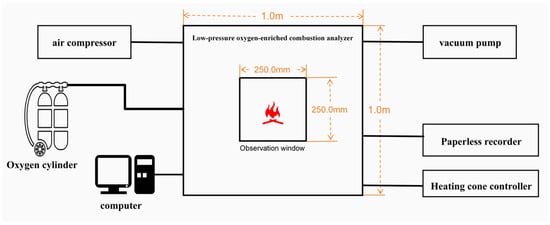
Figure 2.
The simplified schematic diagram of a low-pressure oxygen-enriched combustion analysis platform.
2.3. Electric Control Conical Radiant Heater
To simulate the real fire scene in a low-pressure oxygen-enriched environment in the plateau area, an electronically controlled cone-shaped radiant heater designed based on the ISO 5660-1 [] standard was installed in the low-pressure oxygen-enriched combustion chamber (as shown in Figure 3). A heater was used to provide an accurate and stable radiant heat flux. It achieves ±2% heat flux stability through PID closed-loop control. Simultaneously, it integrates double thermocouple overtemperature protection and a water cooling circulation system to ensure safe operation.
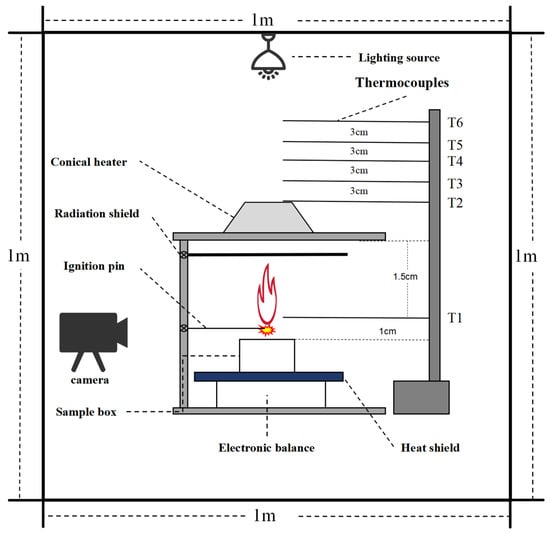
Figure 3.
Simplified schematic diagram of combustion chamber interior.
The experimental system included an electric rotary radiation shield and a needle igniter, which was fixed at (10 ± 2) mm above the sample. The sample quality change was monitored in real time through an electronic balance connected at the bottom (measuring range 35 kg, accuracy 0.1 g). After the heat flux became stable, the radiation shield was removed, and the ignition procedure was initiated within 1 s using the control button outside the cabin. If the flame continued to appear, ignition was considered successful. At this time, the igniter automatically closed and reset, and triggered the data acquisition system to record parameters such as flame shape, ignition time, continuous combustion time, and quality change.
2.4. Experimental Configuration and Steps
A low-pressure environment of 70 kPa was simulated in this study, in accordance with the GB/T 35414-2017 [] standard for indoor oxygen supply in plateau regions. The applied pressure of 70 kPa corresponds to the standard atmospheric pressure at an altitude of 3000 m, thereby replicating conditions common to plateau environments in China and ensuring direct engineering applicability. Five oxygen concentrations (21%, 25%, 27%, 30%, and 35%) were tested in a low-pressure environment of 70 kPa. Among these, the 30.0% concentration was established as the reference condition, as it yielded a partial pressure of oxygen equivalent to that of normoxic air at sea level (21% O2, 101 kPa). Using this as a reference, lower concentrations of 21% and 25% simulate environments ranging from natural high-altitude hypoxia to artificially supplemented oxygen conditions, whereas higher concentrations of 27% and 35% simulate environments from moderately to highly oxygen-enriched conditions. Fifteen fire scenarios were designed by incorporating these five oxygen concentrations across three heat flux gradients, as detailed in Table 1.

Table 1.
Test conditions.
Each test configuration was repeated thrice to minimize errors. The chamber pressure was first reduced to 70 kPa using a water-ring vacuum pump. Following the initial evacuation, the pumping rate was fine-tuned, and a stable pressure was maintained through the collaborative operation of the vacuum pump and an air compressor. Therefore, oxygen was introduced until the target concentration was reached. Following the stabilization of the cabin pressure and oxygen concentration, the experiment was initiated. The air and oxygen flow meters were subsequently adjusted in real time to ensure that these parameters remained close to their set points. When the experiment was started, the conical heater was activated to the predetermined thermal radiation intensity, and the radiation cover was removed for ignition after it was stable. After successful ignition, the igniter will be automatically turned off, and the data acquisition system will be started to record the combustion parameters, during which the dynamic balance between cabin pressure and oxygen concentration will be maintained. The mass loss was continuously tracked in real-time utilizing an electronic balance that had a precision of 0.01 g. The flame temperature was measured using six K-type armored thermocouples (T1–T6, wire diameter 0.5 mm, node diameter 1 mm). The thermocouples were arranged vertically along the flame centerline, and the lowest point (T1) was 10 mm from the sample surface. To reduce the measurement error caused by thermal radiation, all thermocouples were of the double bare node structure, and multipoint temperature calibration (200–1000 °C) was performed before the experiment. Following the test, the combustion chamber was opened after its internal pressure equilibrated with the ambient atmosphere. Subsequently, any carbon deposits on the thermocouple were carefully cleaned.
3. Results and Discussion
3.1. Burning Phenomenon
The combustion of solid combustibles is a process involving complex physical and chemical changes, which usually goes through the stages of drying and evaporation, thermal decomposition, ignition and combustion, severe combustion, and flame decay until extinguishment. Figure 4 shows the typical combustion phenomenon of WPCs under low pressure and normal oxygen conditions (70 kPa, 21%).
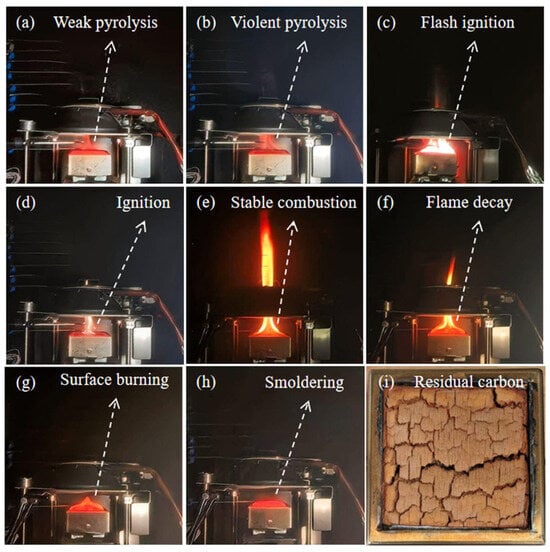
Figure 4.
Typical combustion phenomena of WPCs under low-pressure and normoxic conditions.
Under the action of thermal radiation, the water in the WPCs evaporated until the material was dry. At 4 s, it entered the weak decomposition stage, and the sample released a small amount of water vapor and combustible gas (Figure 4a), creating conditions for subsequent combustion. As the reaction proceeds, the material carbonizes, and the center color deepens, entering the stage of intense pyrolysis, accelerating the production of more water vapor and combustible gases, forming white gray smoke, and precipitating (Figure 4b). The combustible gas was mixed with air on the sample surface to form a premixed gas. After the concentration reached the standard, flashover occurred within 43 s (Figure 4c), but the sample was not ignited. At 46 s, the sample reached the ignition point, and a stable flame was established in the central area [] (Figure 4d), and the flame quickly spread to the entire surface to form stable combustion (Figure 4e). After a period of stable combustion, the flame decreased (Figure 4f), and the flaming combustion weakened owing to the reduction in combustible gases in the wood. At 2390 s, oxygen diffused to the carbon surface, causing surface combustion (Figure 4g). When flaming and surface combustion are carried out simultaneously for a period of time, flaming combustion turns to smoldering at 3555 s after the sample stops releasing combustible gas (Figure 4h). After combustion, the residue was loose and easily powdered carbon residue (Figure 4i).
3.2. Ignition Time and Duration of Combustion
3.2.1. Ignition Time
Ignition time is a crucial indicator for assessing the flammability of solid materials. A prolonged ignition time indicates that the material requires more time to ignite and sustain flames for over 10 s, which is indicative of superior flame-retardant properties [,].
Figure 5 shows the ignition time measurements corresponding to the three distinct heat flux densities. Under low-pressure conditions, an elevated heat flux density and oxygen concentration can reduce the ignition time. Specifically, at a heat flux density of 25 kW/m2, the ignition time was prolonged, and smoldering occurred in certain instances. As the oxygen concentration increased from 21% to 35%, the ignition time decreased from approximately 75 s to 46 s. At a heat flux density of 35 kW/m2, the ignition time was markedly reduced, and with the oxygen concentration rising from 21% to 35%, the ignition time decreased from approximately 45 s to 26 s. The shortest ignition time was observed at a maximum heat flux density of 50 kW/m2. When the oxygen concentration increased from 21% to 35%, the ignition time decreased from approximately 28 s to 16 s.
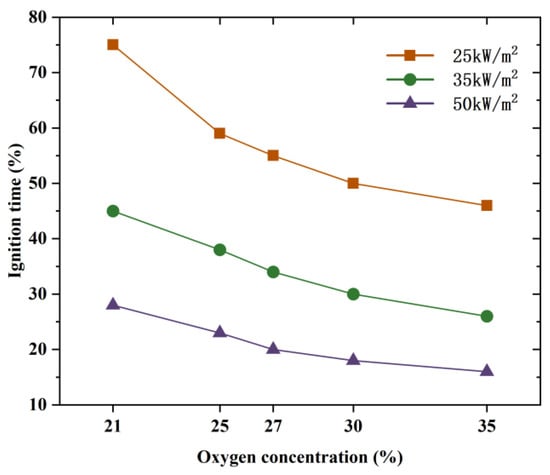
Figure 5.
Ignition time of WPCs.
The results demonstrate that at lower heat flux densities, there is a more pronounced correlation between ignition time and oxygen concentration. Conversely, at higher heat flux densities, the dominant factors become the enhancement of surface heat transfer and the increased fuel evaporation rate, while the impact of oxygen concentration on ignition time diminishes. Furthermore, when comparing environments with low oxygen concentration and low heat radiation (21–25 kW/m2) to those with high oxygen concentration and high heat radiation (35–50 kW/m2), the ignition time of the material is reduced by over 78%. This significant reduction highlights the heightened flammability of the material under extreme conditions.
The ignition time can be approximated as the combined duration of pyrolysis and chemical induction []. Under standard atmospheric conditions, the premixing duration of combustible gases is sufficiently brief to be negligible. The ignition time is represented as follows:
For thick combustible materials, the pyrolysis time of the materials []:
The expression for chemical induction times []:
In the formula: is the thermal conductivity coefficient; is the density of the material; is the specific heat capacity; is the surface temperature of solid ignition; is the initial temperature; represents the re radiation heat flux, and represents the external heat flux; is the ambient temperature; is the critical Damkeler number; is the Damkole number.
The increase in external heat flux will increase the denominator term, thus shortening the , which also explains the acceleration of pyrolysis process with the increase in heat flux intensity. In addition, the increase in oxygen concentration directly affected the Damköler number, reduced the critical Damköler number, and then reduced the chemical induction time. In the low-pressure environment, the improvement in oxygen diffusion efficiency further enhanced the oxidation reaction rate, and the synergistic effect with heat flow input decreased the ignition time with increasing oxygen concentration and heat flow density.
3.2.2. Duration of Combustion
Extended burning duration correlates with the prolonged maintenance of wood’s structural integrity during a fire. Figure 6 illustrates the combustion times of the WPCs under various conditions. At a constant thermal radiation intensity, the combustion time increased as the oxygen concentration decreased. This trend is attributed to the diminished number of oxygen molecules per unit volume, which slows the gas-phase combustion reaction rate and weakens the thermal feedback to the unburned surface. In low-pressure environments, the diminished oxygen concentration complicates the interaction between combustible gases and oxygen. As the fuel concentration near the material surface peaked, the oxygen concentration was nearly depleted, and combustion was confined to a specific range of fuel-to-oxygen ratios. The lower oxygen concentration slows the diffusion of the oxidant to the combustion zone, thus weakening the combustion intensity. At the same oxygen concentration, the combustion time decreased with increasing thermal radiation intensity. For example, when the oxygen concentration was 21%, the thermal radiation intensity increased from 25 to 50 kW/m2, and the combustion time decreased from 2734 s to less than 1790 s, indicating that a higher thermal radiation intensity accelerated the pyrolysis and combustion processes of the material. In addition, the effect of oxygen concentration on combustion duration was more obvious at a low heat flux. At a high heat flux, the combustion duration was dominated by radiation flux, and the effect of oxygen concentration was relatively small.
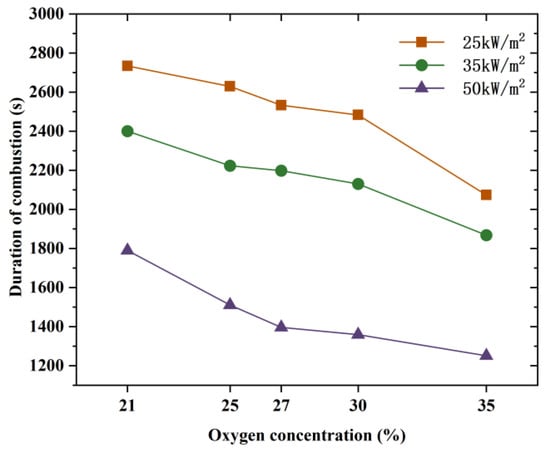
Figure 6.
Combustion duration of WPCs.
3.3. Flame Shape and Height
As an important parameter for exploring fire risk, the flame shape can reflect the combustion state and development direction of the fire in real time, which is crucial for reducing casualties and economic losses. The entire process of WPCs from ignition to extinction was recorded using a high-speed camera. As depicted in Figure 7, both the flame height and width decreased as the oxygen concentration increased, and the maximum flame height also decreased with increasing oxygen concentration.
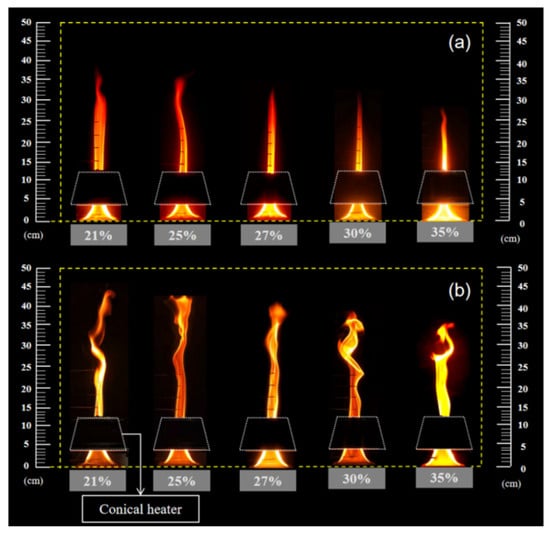
Figure 7.
Flame height (a) and maximum flame height (b) of WPCs under different oxygen concentrations of 50 kW/m2.
The combustion of WPCs involves a complex oxidation mechanism. Variations in oxygen concentration influence soot formation and flame temperature, thereby altering the appearance and hue of the flame []. In contrast to the combustion behavior of corrugated cartons reported in the existing literature [], this experiment observed that the flame height and width of the WPCs decreased significantly with increasing oxygen concentration. This discrepancy can be ascribed to the fundamental distinctions in the compositional makeup and combustion processes of these two materials. As a homogeneous cellulose material, the combustion process of corrugated boxes is dominated by gas-phase reactions. The rise in oxygen concentration predominantly facilitated the expansion of the flame area, thereby leading to an enlargement of the flame dimensions. WPCs are heterogeneous materials composed of wood fibers and polyethylene (PE), and their combustion behavior involves the coupling of solid-phase pyrolysis and gas-phase combustion. Under high oxygen conditions, the intense gas-phase combustion reaction significantly increases the flame temperature, accelerates the pyrolysis process of the material surface through radiant heat feedback, and improves the release rate of combustible volatiles. However, the rapid enhancement of the combustion reaction also shortens the residence time of the volatile matter in the flame zone and shrinks the reaction zone to the fuel surface, thus inhibiting the longitudinal and transverse expansion of the flame and forming a more compact flame structure. In addition, the increase in oxygen concentration promoted combustion integrity, reduced soot generation, and changed the flame color from blue yellow to bright yellow. In particular, at an oxygen concentration of 35%, the WPCs burned violently, and the flame presented a typical high-temperature bright yellow.
Figure 8 shows the quantitative relationship between the maximum flame height after statistical processing and oxygen concentration under different thermal radiation intensities and its linear regression model. There was a linear negative correlation between the maximum flame height and oxygen concentration under different thermal radiation intensities (R2 = 0.97–0.98, p < 0.001). Specifically, when the oxygen concentration increased from 21% to 35%, the maximum flame heights at 25, 35, and 50 kW/m2 decreased by 50%, 44.4%, and 40.4%, respectively, and the absolute value of the regression slope decreased with an increase in thermal radiation intensity. In addition, the intercept of the regression model increased with an increase in thermal radiation intensity; however, the intercept difference between 35 kW/m2 and 50 kW/m2 was reduced to 4.2%, which is highly consistent with the theory of critical heat flux []. When the thermal radiation intensity exceeds the spontaneous combustion threshold of the material, the rate of pyrolysis gas production reaches a saturated state, and the gaseous combustion process, controlled by oxygen diffusion, becomes the dominant mechanism.

Figure 8.
Linear fitting results of maximum flame height of WPCs under different conditions.
3.4. Mass Loss and Mass Loss Rate
3.4.1. Mass Loss
Mass loss (ML) has attracted considerable attention as a key parameter for quantifying the combustion characteristics of solid materials. The mass loss data were standardized (real-time mass/initial mass × 100%), which effectively eliminated the interference of the discreteness of the initial mass of the sample. Figure 9 shows the mass evolution of WPCs under the coupling effect of gradient heat flux (25–50 kW/m2) and step oxygen concentration (21–35%).
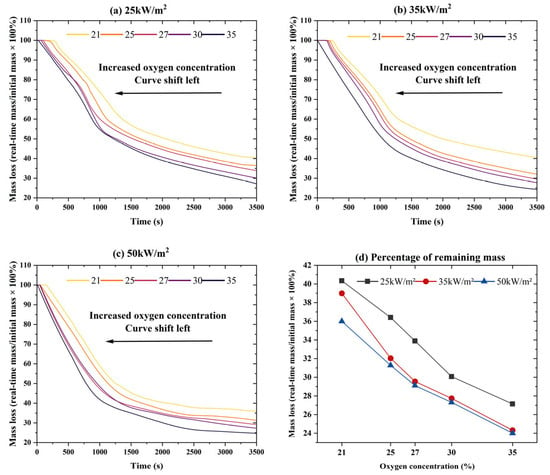
Figure 9.
Quality changes in WPCs under different conditions.
Under the condition of constant heat flux, the curve moves to the left with the increase of oxygen concentration. According to Fick’s first law, , The increase of oxygen concentration leads to the increase in gas phase oxygen partial pressure gradient , which directly leads to the increase of oxygen diffusion flux J; Simultaneously, the diffusion coefficient D increases with increasing molecular spacing, which increases the oxygen transport rate at the interface, intensifies the combustion reaction, and finally increases the ML. In addition, with an increase in the heat flux, the curve moved to the left, and the slope increased. This indicates that the mass loss rate of the WPCs was faster at higher heat fluxes.
Figure 9d shows that the higher the heat flux and oxygen concentration, the lower the residual mass percentage. With an increase in heat flux, the radiation energy received by the material surface increased significantly, which accelerated the pyrolysis process and promoted the rapid release of volatile matter. Simultaneously, the increase in oxygen concentration enhanced the gas-phase combustion reaction intensity and caused the volatiles to oxidize and burn more completely, both of which led to the aggravation of material mass loss. In addition, when the oxygen concentration exceeded 25%, the three attenuation curves exhibited a convergence trend and almost coincided at heat fluxes of 35 and 50 kW/m2. This may be because, in a high-oxygen environment, the combustion reaction changes from oxygen diffusion control to pyrolysis kinetics control, and the pyrolysis rate of the material becomes the dominant factor. When the heat flux reached the critical value, the rapid formation of the surface carbonization layer blocked the further penetration of heat, resulting in the pyrolysis process not being significantly accelerated at higher heat flux (50 kW/m2), thus showing a similar mass loss behavior.
3.4.2. Mass Loss Rate
The derivative of mass loss (ML) over time, known as the MLR, reflects the rate of change in material combustion consumption over time. The MLR is not only closely related to the thermal decomposition rate of materials but can also be used to assess the fire risk level of materials. This study selected data from the lower heat flux condition (25 kW/m2) for further analysis, given the consistent change trend of MLR under different heat flux conditions (Figure 10).

Figure 10.
Mass loss rate of WPCs.
At a heat flux of 25 kW/m2, the mass loss rate (MLR) curve of the WPCs showed an overall left shift trend with increasing oxygen concentration, and the MLR peak increased with increasing oxygen concentration. This phenomenon shows that an increase in oxygen concentration promotes the combustion reaction of the material, making the mass loss process more rapid and violent. The MLR curve of the WPCs showed obvious “double peak” characteristics, which reflected the staged combustion behavior of multi-components in the material. The first peak may be due to the rapid pyrolysis of wood fiber components at high temperatures and the instantaneous release of volatile products, whereas the second peak may be due to the delayed pyrolysis of the plastic matrix and the secondary combustion of the carbon layer. When the oxygen concentration decreased from 35% to 21%, the shift in the double peaks to the right indicated that the combustion process was delayed, and the decrease in the peak value indicated that the combustion rate was reduced. At 21% oxygen concentration, the bimodal peak decreased by 35% and 30% compared with 35% oxygen concentration, respectively, and the distribution time was delayed from 60 s/780 s to 70 s/932 s. This change can be attributed to the deterioration of combustion conditions caused by the reduction in oxygen concentration, which delayed the reaction rate between pyrolysis products and oxygen and reduced the sufficiency of the combustion reaction.
The change trend of the MLR curve was observed under an oxygen concentration of 21% (Figure 10b). The combustion process can be divided into four main stages: (I) wood powder pyrolysis, (II) stable combustion, (III) intense combustion, and (IV) attenuation. In the pyrolysis stage (I) of wood flour, wood fibers decompose rapidly at high temperatures, releasing volatile components and generating combustible gases. This process increased the flame height and combustion rate, resulting in a sharp increase in the MLR curve and the formation of an initial mass loss peak. As the burning of volatile matter gradually exhausted, the MLR curve decreased briefly and entered the stable combustion stage (II). At this stage, the MLR gradually increased, the flame height tended to be stable, and the flame heat feedback, external radiant heat flow, and heat required for heating and evaporation reached a quasi-equilibrium state. It then entered the stage of intense combustion (III). At this time, the plastic matrix (such as polyethylene, PE) reached the pyrolysis threshold owing to the accumulation of thermal radiation, and its melting and pyrolysis processes released secondary volatiles, causing intense combustion. At this stage, the combustion intensity and flame height increased rapidly in a short time, showing the second peak of the MLR curve. Finally, when combustion was near the end, the combustion rate and flame height continued to decline, indicating that the combustion process had entered the attenuation stage (IV). At this stage, with the gradual depletion of combustible components, the combustion intensity decreases and finally tends to extinguish.
3.5. Flame Temperature
The structure of the fire plume in the vertical direction can be divided into three main areas: continuous flame, intermittent flame, and buoyancy plume areas []. Under the action of air entrainment, the flame converged along the centerline to form a stable combustion region. The heat release rate (HRR) of a WPC fire primarily determines the flame temperature at a fixed position in the fire plume. The results indicate that the higher the heat release rate, the higher is the flame temperature at the same position. The heat release rate is closely related to the combustion heat and mass loss rate (MLR) of the fuel; therefore, the flame temperature curve exhibits a “double peak” characteristic similar to the MLR curve. Figure 11 shows the variation in the flame Centerline Temperature under different experimental conditions.
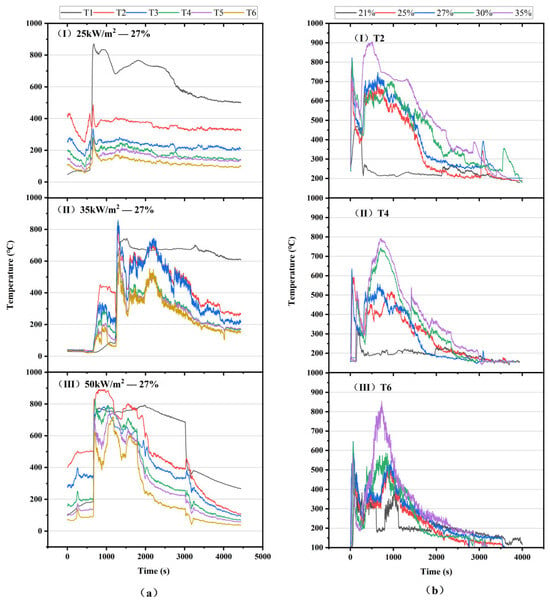
Figure 11.
(a) Flame center temperature profiles under three typical heat fluxes (25 kW/m2, 35 kW/m2, 50 kW/m2) at 27% oxygen concentration, and (b) temperatures at different measurement points (T2, T4, T6) under various oxygen concentrations with a heat flux of 35 kW/m2.
Figure 11a shows the flame temperature changes in the thermocouples at different heights of the flame centerline under the conditions of 27% oxygen concentration and three different heat fluxes. Thermocouple T1, which was positioned near the upper surface of the sample and the conical heater, experienced a rapid initial temperature rise to approximately 800 °C before gradually stabilizing. In contrast, at the moment of ignition of the sample, thermocouples T2 to T6 recorded a sharp rise in temperature and reached the first peak, which fluctuated slightly during the stable combustion stage; however, in the violent combustion stage, as the plastic matrix combusted violently, the temperature reached a second peak. A negative correlation was observed between the flame temperature distribution and the height of the thermocouple because the thermocouple located in the lower region of the flame was mainly affected by the flame pulsation, whereas the thermocouple located at a higher position recorded the temperature gradually increasing with the rising of the flame. In addition, a higher external heat flux enhances the combustion intensity and increases the average flame temperature. At a lower heat flux (25 kW/m2), the fluctuation of the temperature curve was relatively gentle, and the maximum temperature peak was significantly reduced.
Figure 11b shows a comparison of the flame temperature changes recorded by thermocouples T2, T4, and T6 at different heights of the flame centerline under the conditions of 35 kW/m2 heat flux and different oxygen concentrations. We found that the flame temperature consistently increased as the oxygen concentration increased at all measurement positions. Specifically, when the oxygen concentration increased from 21% to 35%, the maximum flame temperature at T2 increased from 466 °C to 902 °C, an increase of 94%. The maximum flame temperature at T4 increased by 137% from 334 °C to 792 °C. The maximum flame temperature at T6 increased by 79% from 478 °C to 854 °C. This phenomenon is mainly attributed to the fact that an increase in oxygen concentration enhances the oxidation reaction rate of the fuel, which in turn increases the heat release rate and flame temperature. The highest temperature of the flame mostly appeared at T2 above the heating cone, which was located in the continuous combustion zone of the flame, and its measured temperature could accurately reflect the actual temperature of the flame. The temperature changes in T4 and T6 also showed similar regularity, indicating that the oxygen concentration has an important influence on the temperature distribution of the entire flame plume.
Notably, during the late stage of combustion (approximately 3600 s), the temperatures measured by thermocouples T4 and T6, located in the mid-to-upper region of the flame plume, stabilized in the range of 100–200 °C, which was significantly lower than the peak temperatures in the continuous flame zone. This phenomenon can be attributed to three factors. First, spatial position plays a critical role. T4 and T6, positioned 6 cm and 12 cm above the sample surface, respectively, were situated in the intermittent flame or buoyant plume region, far from the intensely reacting continuous flame core. This resulted in a substantial reduction in the combustion reaction intensity and heat-release rate at these locations. Second, the low-pressure environment (70 kPa) led to a decrease in the air density and volumetric heat capacity, thereby weakening the heat transport capacity and convective heat transfer efficiency of the air. This impedes the effective transfer and accumulation of heat in the upper plume region. Finally, during the decay stage of combustion, the flammable volatiles from both the wood fibers and plastic matrix were nearly depleted. The flame intensity and total heat release rate naturally decay, directly leading to a decline in the overall plume temperature. The combined effect of these factors results in the low-temperature characteristics observed at the T4 and T6 measurement points during the late combustion stage.
4. Conclusions
A novel integrated system for multiparameter synchronous testing was developed, comprising an electronically controlled cone heater and a low-pressure oxygen-enriched combustion platform, to simulate artificially oxygen-enriched indoor fire scenarios in plateau environments. Using this setup, the effects of varying oxygen concentrations (21–35%) and external heat fluxes (25, 35, and 50 kW/m2) on the combustion characteristics of wood–plastic composites (WPCs) under low pressure (70 kPa) were systematically investigated.
Higher oxygen concentrations and heat flux accelerated the combustion of WPCs under low-pressure conditions, thereby significantly shortening both the ignition and burning times. The fire risk of WPCs is therefore markedly elevated in low-pressure, oxygen-enriched environments. Furthermore, the influence of oxygen concentration on ignition time diminished with increasing heat flux, indicating that high heat flux becomes the dominant mechanism governing combustion behavior under such conditions.
Unlike homogeneous cellulosic materials (e.g., corrugated cartons), the flame height and width of the WPCs decreased linearly with increasing oxygen concentration. The maximum flame height declined by 50%, 44.4%, and 40.4% under heat fluxes of 25, 35, and 50 kW/m2, respectively (R2 ≥ 0.97, p < 0.001). The flame structure became more compact, and its color shifted from blue-yellow to bright yellow. The heterogeneous nature of WPCs leads to coupled solid-phase pyrolysis and gas-phase combustion. Under high-oxygen conditions, the gas-phase reaction was enhanced, causing the flame to contract toward the sample surface, and combustion transitioned to oxygen diffusion control. Moreover, a higher heat flux weakened the suppressive effect of the oxygen concentration on the flame dimensions.
The mass loss rate (MLR) curve of the WPCs exhibited a distinct “double-peak” pattern, providing direct evidence of the staged pyrolysis of wood fibers, followed by the delayed combustion of the plastic matrix. Increases in the oxygen concentration and heat flux accelerated mass loss. However, under high heat flux (≥35 kW/m2) and high oxygen concentration (≥25%) conditions, the mass loss behavior became more uniform, suggesting a transition in the dominant combustion mechanism from oxygen diffusion control to pyrolysis kinetics.
The flame temperature profile also displayed a “double-peak” characteristic, showing strong synchronization with the MLR variations and further confirming the phased nature of the combustion process. The flame temperature increased significantly with increasing oxygen concentration. When the oxygen concentration increased from 21% to 35%, the maximum temperature in the continuous flame zone (measured at point T2) increased by nearly 94%, indicating a substantial enhancement in the combustion reaction intensity under high-oxygen conditions.
Author Contributions
Conceptualization, X.J.; Validation, W.L.; Formal analysis, W.L. and S.T.; Investigation, W.L.; Resources, X.J. and W.C.; Data curation, S.T.; Writing—original draft, W.L.; Writing—review & editing, W.L.; Supervision, X.J.; Project administration, X.J.; Funding acquisition, W.C. All authors have read and agreed to the published version of the manuscript.
Funding
This research was funded by the Sichuan Provincial Science and Technology Plan Project (grant number 2025YFHZ0054), the Sichuan Provincial Natural Science Foundation (grant number 2025ZNSFSC0347), and the Wan Chow Research Initiation Project (grant number XYKY2025002).
Data Availability Statement
The original contributions presented in this study are included in the article. Further inquiries can be directed to the corresponding author.
Conflicts of Interest
The authors declare that they have no known competing financial interests or personal relationships that could have appeared to influence the work reported in this paper. This manuscript is approved by all authors for publication. We hereby confirm that the submitted work is original, has not been published previously, and is not under consideration for publication elsewhere, in whole or in part.
References
- Ruan, J.; Shen, G.; Dong, X.; Lei, T.; Luo, E. Research progress and application status of anti-hypoxia equipments in plateau region. Med. Gas Eng. 2017, 2, 7–10. (In Chinese) [Google Scholar]
- West, J.B. Fire hazard in oxygen-enriched atmospheres at low barometric pressures. Aviat. Space Environ. Med. 1997, 68, 159–162. [Google Scholar] [PubMed]
- Yansui, L.; Ren, Y. The spatial characteristics and formation mechanism of the county urbanization in China. Acta Geogr. Sin. 2012, 67, 1011–1020. [Google Scholar]
- West, J.B. Oxygen enrichment of room air to improve well-being and productivity at high altitude. Int. J. Occup. Environ. Health 1999, 5, 187–193. [Google Scholar] [CrossRef]
- West, J.B. Safe upper limits for oxygen enrichment of room air at high altitude. High Alt. Med. Biol. 2001, 2, 47–51. [Google Scholar] [CrossRef]
- West, J.B. Commuting to high altitude: Value of oxygen enrichment of room air. High Alt. Med. Biol. 2002, 3, 223–235. [Google Scholar] [CrossRef]
- Shen, F.C.; Jia, R.L. Research Progress and Prospect of Wood-Plastic Composites. Plast. Addit. 2010, 5–9. (In Chinese) [Google Scholar] [CrossRef]
- Dong, S.J.; Zhou, G.S. Research and Prospect of Wood-Plastic Composites. Mater. Rep. Energy. 2009, 23, 61–64. (In Chinese) [Google Scholar]
- Friedman, R. Fire Safety in the Low-Gravity Spacecraft Environment; Technical Paper 1999-01-1937; SAE International: Warrendale, PA, USA, 1999; pp. 1–18. [Google Scholar]
- Simons, D.; Archibald, E. Selection of a sealed cabin atmosphere. J. Aviat. Med. 1958, 29, 7. [Google Scholar]
- Dorr, V. Fire studies in oxygen-enriched atmospheres. J. Fire Flammabl. 1970, 1, 91–106. [Google Scholar]
- McAllister, S.; Fernandez-Pello, C.; Urban, D.; Ruff, G. The combined effect of pressure and oxygen concentration on piloted ignition of a solid combustible. Combust. Flame 2010, 157, 1753–1759. [Google Scholar] [CrossRef]
- Nakamura, Y.; Aoki, A. Irradiated ignition of solid materials in reduced pressure atmosphere with various oxygen concentrations–for fire safety in space habitats. Adv. Space Res. 2008, 41, 777–782. [Google Scholar] [CrossRef]
- Hirsch, D.; Williams, J.; Beeson, H. Pressure effects on oxygen concentration flammability thresholds of polymeric materials for aerospace applications. J. Test. Eval. 2008, 36, 69–72. [Google Scholar] [CrossRef]
- Hirsch, D.B.; Williams, J.H.; Harper, S.A.; Beeson, H.; Pedley, M.D. Oxygen concentration flammability thresholds of selected aerospace materials considered for the constellation program. In Proceedings of the 2nd IAASS Conference Space Safety in Global World, Chicago, IL, USA, 14–16 May 2007. [Google Scholar]
- Osorio, A.F.; Fernandez-Pello, C.; Urban, D.L.; Ruff, G.A. Limiting conditions for flame spread in fire resistant fabrics. Proc. Combust. Inst. 2013, 34, 2691–2697. [Google Scholar] [CrossRef]
- Xu, H.; Yu, H.; Chu, F.; Wang, Z.; Hu, W.; Song, L.; Hu, Y. Effect of sub-atmospheric pressure on combustion and pyrolysis behavior of flame-retardant polyethylene. Int. J. Therm. Sci. 2025, 215, 110028. [Google Scholar] [CrossRef]
- Zhang, J.; Ji, W.; Yuan, Y.; Sun, Q.; Tang, F. Effect of low atmospheric pressure on combustion characteristics of polypropylene: An experimental investigation. Appl. Therm. Eng. 2025, 265, 125545. [Google Scholar] [CrossRef]
- ISO 5660-1:2002; Reaction-to-Fire Tests, Heat Release, Smoke Production, and Mass Loss Rate—Part 1: Heat Release Rate (Cone Calorimeter Method). ISO: Geneva, Switzerland, 2002.
- GB/T 35414-2017; Requirements for Diffuse Oxygen Supply (Oxygen Modulation) in Indoor Space in Plateau Area. State Administration of Market Supervision, China National Standardization Administration Committee: Beijing, China, 2017.
- Quintiere, J.G. Fundamentals of Fire Phenomena; John Wiley & Sons, Ltd.: Hoboken, NJ, USA, 2006. [Google Scholar]
- Apte, V. Flammability Testing of Materials Used in Construction, Transport, and Mining; Woodhead Publishing: Cambridge, UK, 2021. [Google Scholar]
- Dao, D.Q.; Luche, J.; Richard, F.; Rogaume, T.; Bourhy-Weber, C.; Ruban, S. Determination of characteristic parameters for the thermal decomposition of epoxy resin/carbon fibre composites in cone calorimeter. Int. J. Hydrogen Energy 2013, 38, 8167–8178. [Google Scholar] [CrossRef]
- Cox, G. Combustion Fundamentals of Fire; Academic Press: Oxford, UK, 1995. [Google Scholar]
- Poirier, D.; Geiger, G. Conduction of heat in solids. In Solutions Manual to Accompany Transport Phenomena in Materials Processing; Springer International Publishing: Cham, Switzerland, 2016; pp. 281–327. [Google Scholar]
- Niioka, T.; Takahashi, M.; Izumikawa, M. Gas-phase ignition of a solid fuel in a hot stagnation-point flow. Symp. (Int.) Combust. 1981, 18, 741–747. [Google Scholar] [CrossRef]
- Wang, W.-G.; Kong, W.-J.; Zhang, P.-Y. Experimental studies on flame spread across thermally thin solid fuel surfaces under lower ambient pressures. J. Eng. Thermophys. 2004, 25, 887–890. [Google Scholar]
- Jia, X.; Ma, J.; Tang, J.; Liu, Q.; Zhu, X.; Zhu, Y.; He, Y. Experimental study on the fire behavior of the corrugated cartons under low-pressure environment with oxygen-enriched. Int. J. Therm. Sci. 2023, 193, 108450. [Google Scholar] [CrossRef]
- El Gazi, M.; Sonnier, R.; Giraud, S.; Batistella, M.; Basak, S.; Dumazert, L.; Hajj, R.; El Hage, R. Fire behavior of thermally thin materials in cone calorimeter. Polymers 2021, 13, 1297. [Google Scholar] [CrossRef]
- Zhou, Z.; Wei, Y.; Li, H.; Yuen, R.; Jian, W. Experimental analysis of low air pressure influences on fire plumes. Int. J. Heat Mass Transf. 2014, 70, 578–585. [Google Scholar] [CrossRef]
Disclaimer/Publisher’s Note: The statements, opinions and data contained in all publications are solely those of the individual author(s) and contributor(s) and not of MDPI and/or the editor(s). MDPI and/or the editor(s) disclaim responsibility for any injury to people or property resulting from any ideas, methods, instructions or products referred to in the content. |
© 2025 by the authors. Licensee MDPI, Basel, Switzerland. This article is an open access article distributed under the terms and conditions of the Creative Commons Attribution (CC BY) license (https://creativecommons.org/licenses/by/4.0/).